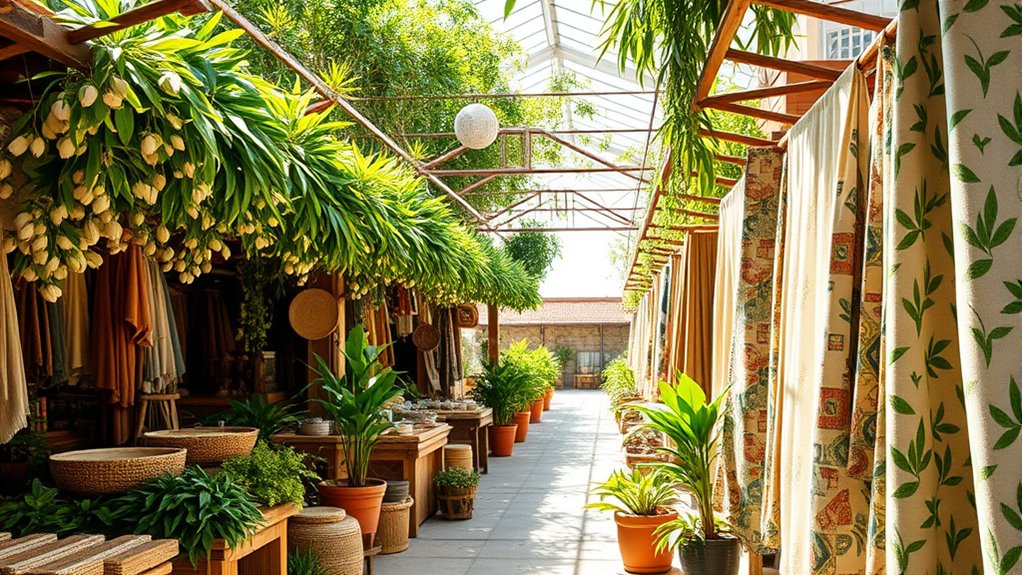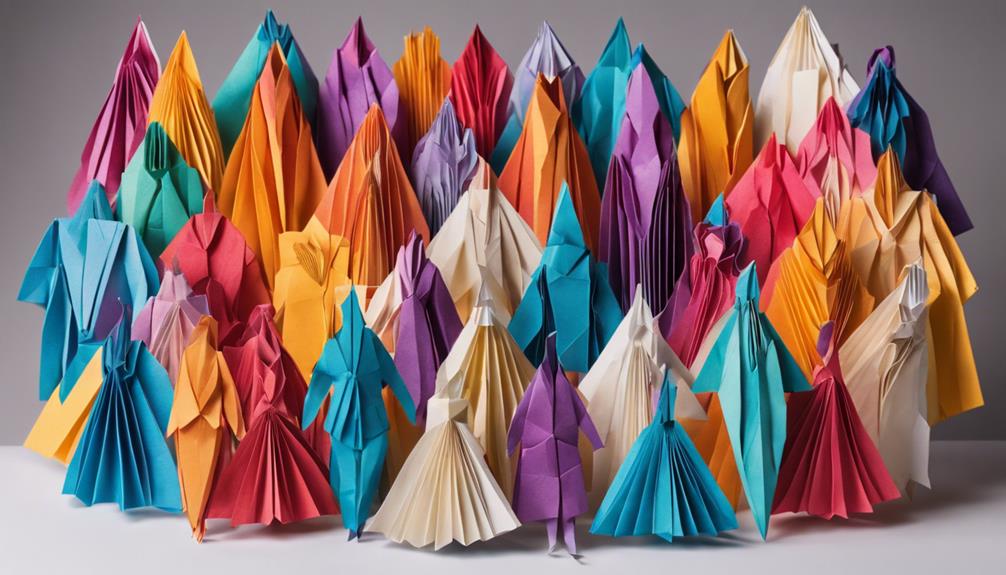In 2025, sustainable fabrics focus on plant-based fibers like hemp, bamboo, and Tencel, which are biodegradable and require less water and chemicals. Recycled plastics and bioengineered textiles are also gaining traction, helping combat waste and pollution. Natural dyes and circular upcycling methods reduce chemical use and extend product life. Innovations in lab-grown fibers and biodegradable materials continue to shape eco-friendly fashion—if you want to explore the latest trends and eco-choices, keep going.
Key Takeaways
- Growing popularity of plant-based fibers like hemp, bamboo, and Tencel due to their biodegradability and eco-friendly cultivation.
- Increased use of recycled and bioengineered textiles, including lab-grown fibers, to reduce waste and minimize environmental impact.
- Innovative eco-friendly dyes from natural sources and circular fashion practices, emphasizing reuse, upcycling, and resource efficiency.
- Consumer engagement strategies focused on transparency, upcycling incentives, and storytelling to promote sustainable fashion choices.
- Advancements in biodegradable and biofabric materials, offering compostable fabrics that support circular lifecycle models and soil health.
The Rise of Plant-Based Fibers
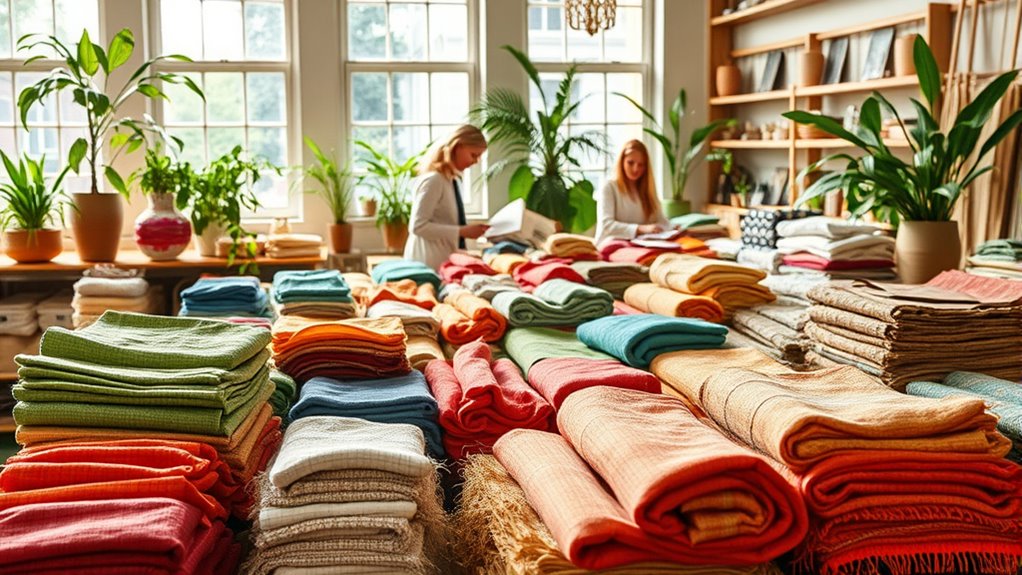
As awareness of environmental issues grows, plant-based fibers are gaining popularity as sustainable alternatives to conventional textiles. You’ll see innovative plant-based innovations that push the boundaries of sustainable fiber development. These fibers, derived from sources like hemp, bamboo, and soy, reduce reliance on fossil fuels and minimize water usage. They’re naturally biodegradable and often require fewer chemicals during processing, making them eco-friendlier options. By choosing fabrics made from these plant-based innovations, you support a shift toward more sustainable fashion. The development of these fibers continues to evolve, offering versatile and durable materials that meet both environmental and consumer needs. Proper storage of these fibers is essential to maintain their quality over time. As a result, plant-based fibers are becoming a key part of the future of eco-conscious textile production.
Recycled Polyester and Plastics
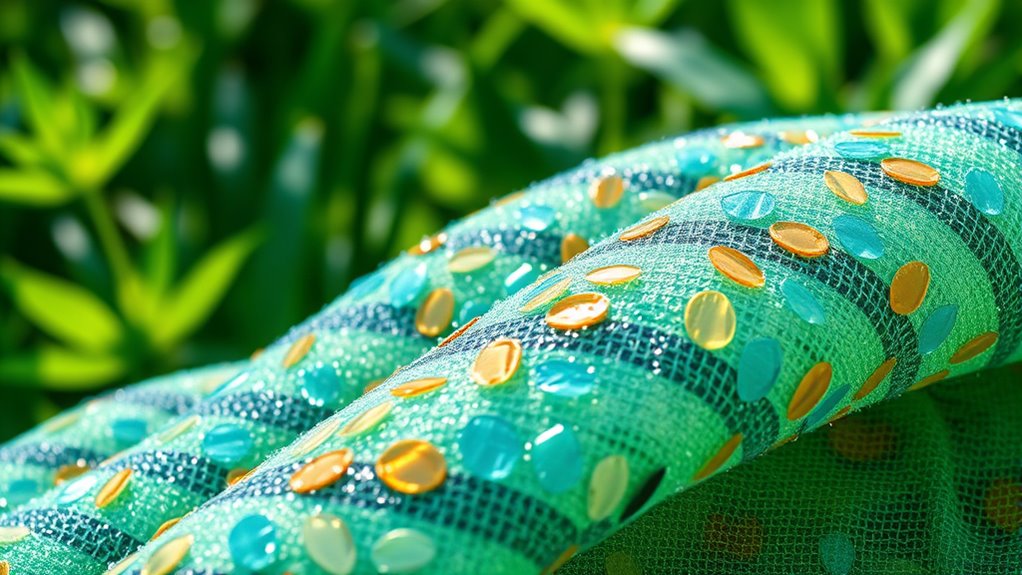
Recycled polyester and plastics are transforming the textile industry by turning waste materials into valuable fibers. This shift helps combat plastic pollution and reduces reliance on virgin resources. By repurposing marine debris and discarded plastics, manufacturers create sustainable fabrics that lessen environmental impact. You’ll find recycled polyester in many eco-friendly apparel lines, offering durability and performance without contributing to plastic pollution. These fibers not only divert waste from oceans but also lower carbon emissions associated with production. To deepen your understanding, consider how recycling processes improve waste management, the role of certifications in ensuring eco-standards, and how recycled plastics can be integrated into circular fashion models. Embracing recycled polyester means supporting a cleaner environment and a more sustainable future for the textile industry.
Innovative Bioengineered Textiles

Bioengineered textiles are transforming the fashion industry with lab-grown fibers that reduce environmental impact. These innovative materials offer eco-friendly benefits, like less water use and fewer chemicals. By choosing these textiles, you can support sustainable practices and enjoy high-performance fabrics. Additionally, some bioengineered textiles incorporate advanced manufacturing techniques that improve durability and functionality.
Lab-Grown Fiber Innovation
Have you ever wondered how scientists are transforming sustainable fashion? Lab-grown fibers are leading the charge, thanks to biotech breakthroughs that enhance fiber sustainability. These innovative bioengineered textiles are created by cultivating microorganisms or cells to produce fibers without traditional farming or mining. This process reduces water, land use, and greenhouse gases, making it a game-changer for eco-conscious fashion. Additionally, advancements in high-performance projectors are inspiring new ways to showcase these sustainable fabrics in immersive environments.
Eco-Friendly Material Benefits
Innovative bioengineered textiles offer significant environmental advantages over traditional fabrics. By utilizing sustainable sourcing methods, these materials reduce reliance on water, pesticides, and land use, minimizing environmental impact. They are engineered to be biodegradable and energy-efficient to produce, further lowering carbon footprints. These textiles can be customized for strength, flexibility, and comfort, making them practical and eco-friendly options. Here’s a quick comparison: biodegradable and customizable
| Feature | Traditional Fabrics | Bioengineered Textiles |
|---|---|---|
| Sourcing | Natural fibers, often resource-intensive | Lab-grown with minimal land use |
| Environmental Impact | High water and pesticide use | Low water, no pesticides |
| Biodegradability | Varies, often synthetic | Designed to biodegrade |
| Production Energy | High energy consumption | Lower energy requirements |
| Customization | Limited | Highly customizable |
You’ll find these textiles are revolutionizing sustainable fashion.
Natural Dyes and Eco-Friendly Coloring Techniques
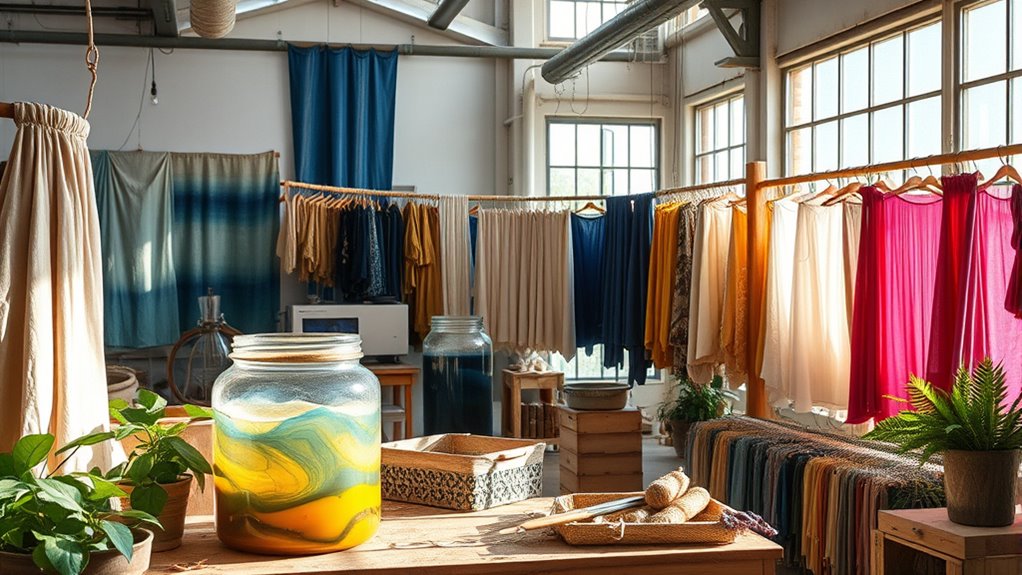
Natural dyes and eco-friendly coloring techniques offer a sustainable alternative to traditional methods that often harm the environment. By choosing natural dyes, you reduce reliance on synthetic chemicals, which can pollute waterways and harm ecosystems. These dyes are derived from plants, minerals, and insects, making them biodegradable and less toxic. Eco friendly coloring methods also emphasize water conservation and energy efficiency, minimizing waste and pollution. Using natural dyes can give your fabrics unique, rich hues that deepen over time. To deepen your understanding, consider these points:
- Sourcing dyes from local, organic plants to lower carbon footprint
- Implementing less water-intensive dyeing processes
- Exploring innovative techniques like solar-powered dyeing systems
- Incorporating vertical storage solutions to organize dyeing supplies and minimize clutter
Switching to natural dyes aligns your practices with sustainability goals, ensuring a greener future for fashion.
Circular Fashion and Upcycling Initiatives
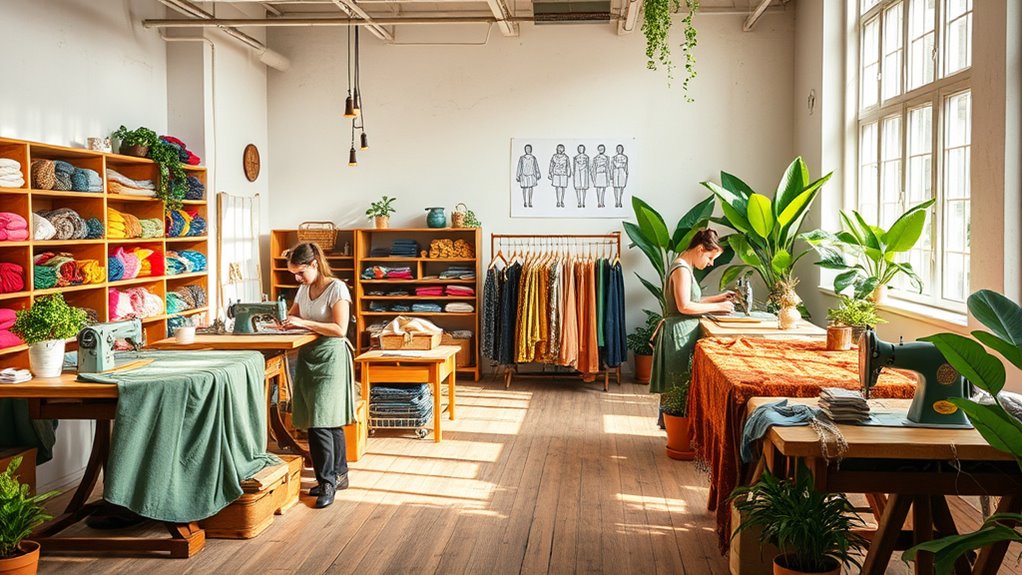
You can make a real difference by supporting innovative upcycling techniques that turn waste into stylish garments. Circular supply chain models guarantee materials stay in use longer, reducing environmental impact. Engaging consumers through education and incentives encourages more sustainable fashion choices every day. Additionally, understanding divorce statistics highlights the importance of legal resources and support systems for individuals navigating life transitions.
Innovative Upcycling Techniques
As the fashion industry seeks to reduce waste and minimize environmental impact, circular fashion and upcycling initiatives have gained momentum as practical solutions. You can participate in innovative upcycling techniques that transform old garments into new, stylish pieces. These methods emphasize textile recycling, which extends the life of fabrics and cuts down on waste. Upcycling not only reduces landfill contributions but also encourages creative reuse.
Some key techniques include:
- Fabric patchwork and embellishments, turning worn-out textiles into unique designs
- Dyeing and finishing processes that refresh old fabrics for new use
- Repurposing scraps into accessories or smaller items, promoting waste reduction
- Incorporating sustainable fabrics that are eco-friendly and reduce environmental impact into upcycled pieces.
Circular Supply Chain Models
Circular supply chain models are transforming the fashion industry by prioritizing resource efficiency and waste reduction through practices like circular fashion and upcycling initiatives. These models emphasize supply chain transparency, so you can trace materials from origin to end-of-life, ensuring responsible management. By adopting ethical sourcing, brands minimize environmental impact and uphold fair labor standards. Circular approaches encourage designers and manufacturers to create products meant to be reused, refurbished, or recycled, reducing reliance on virgin resources. Upcycling initiatives turn waste into valuable materials, closing the loop and extending product life cycles. This shift not only minimizes waste but also fosters consumer trust, as transparency and sustainability become central to brand identity. Incorporating mindfulness practices can further enhance sustainable decision-making and foster a more conscious approach to fashion. Embracing these models positions you at the forefront of the green fashion movement, aligning profits with planet-friendly practices.
Consumer Engagement Strategies
Engaging consumers in circular fashion and upcycling initiatives requires innovative strategies that highlight the environmental and social benefits of sustainable practices. You should actively seek consumer feedback to understand their motivations and concerns, shaping programs that resonate. Transparency is key—sharing the story behind upcycled products and circular processes builds trust and loyalty. To deepen engagement, consider these approaches:
- Showcase transparent supply chain information to emphasize brand transparency
- Offer incentives for returning or upcycling garments, encouraging participation
- Educate consumers through workshops and campaigns that explain the impact of circular initiatives
- Incorporate sustainable fabrics into your product offerings to appeal to eco-conscious shoppers
The Role of Organic and Regenerative Farming
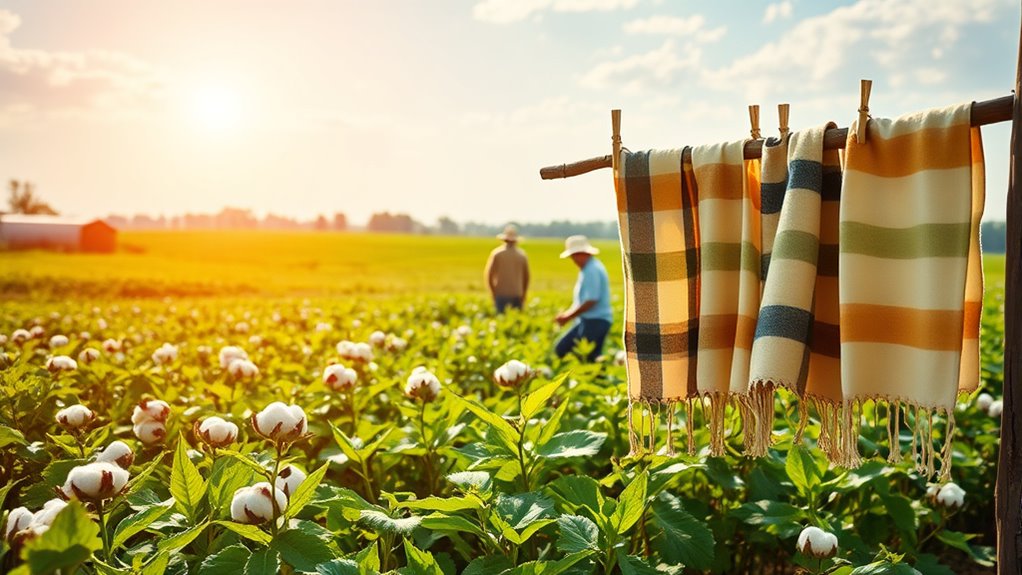
Have you ever wondered how farming methods can influence the sustainability of fabrics? Organic and regenerative farming focus on improving soil health, which is essential for growing durable, eco-friendly fibers. These practices avoid synthetic chemicals, helping to preserve soil vitality and reduce pollution. They also prioritize water conservation, using techniques like crop rotation and cover cropping to minimize water waste. By enriching soil naturally, these methods create healthier ecosystems and reduce the need for resource-intensive inputs. This approach results in fabrics that are not only better for the environment but also more resilient and sustainable in the long run. Incorporating soil health into farming practices is a key factor in producing truly sustainable textiles. Embracing organic and regenerative farming supports a fabric industry that’s environmentally responsible and better aligned with ecological balance.
Biodegradable and Compostable Fabrics
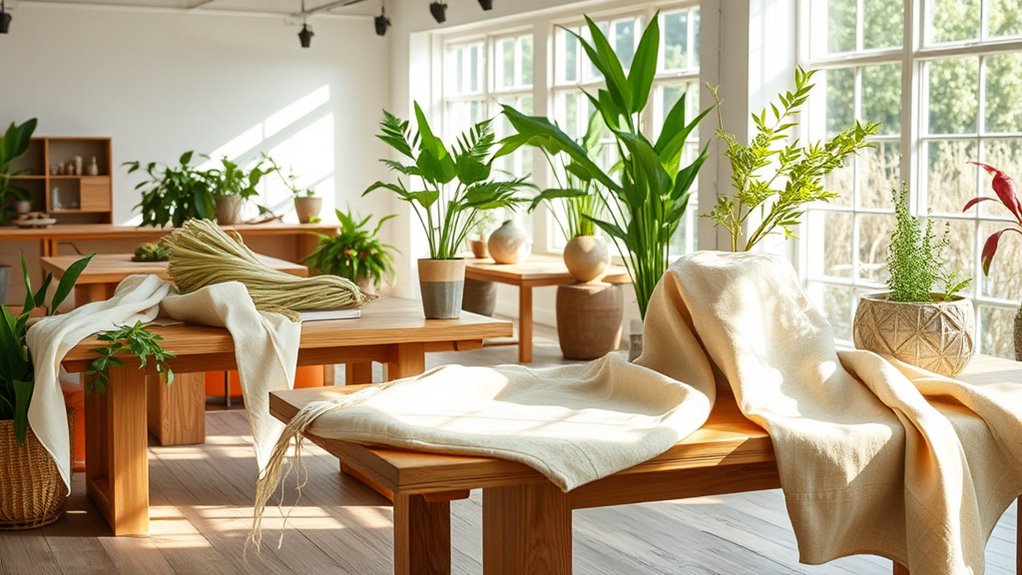
Building on the benefits of organic and regenerative farming, the focus now shifts to fabrics that naturally break down after use. Biodegradable and compostable fabrics offer eco-friendly solutions by returning nutrients to the soil rather than lingering as waste. These materials are ideal for reducing landfill accumulation and can be incorporated into biodegradable packaging and compostable apparel, supporting a circular lifecycle. When you choose these fabrics, you’re helping minimize pollution and promote soil health. Key innovations include plant-based fibers like hemp and Tencel, which decompose quickly and enrich the environment. Additionally, responsible manufacturing methods ensure the fabrics break down efficiently.
Biodegradable fabrics like hemp and Tencel promote soil health and reduce landfill waste naturally.
- Use of natural fibers like hemp and linen
- Compatibility with composting systems
- Reduction of microplastic pollution in waterways
The Future of Lab-Grown and Synthetic Alternatives
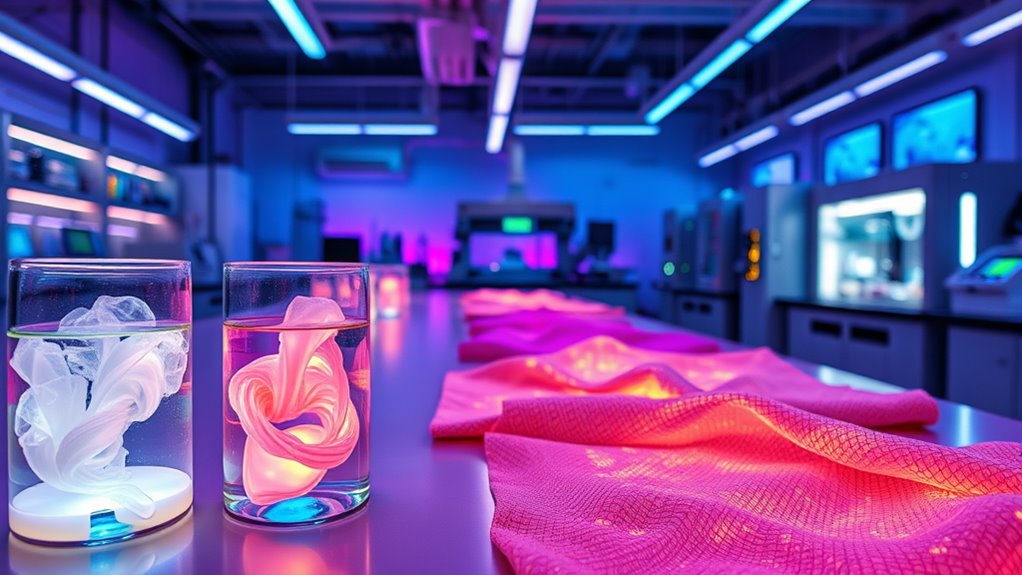
What does the future hold for lab-grown and synthetic fabrics in sustainable fashion? It’s promising, as biofabric innovations continue to evolve, offering eco-friendly options. Lab-grown fabrics, made from cultivated cells, reduce reliance on traditional resource-intensive materials. Meanwhile, advances in biodegradable plastics enable synthetic fabrics to break down more efficiently, minimizing pollution. These innovations aim to create textiles that match or surpass natural fibers in durability and comfort while being environmentally responsible. Expect more brands to adopt lab-grown and synthetic alternatives that prioritize sustainability without sacrificing style. As technology advances, these fabrics will become more affordable and versatile, helping you make greener choices. The future of sustainable fashion hinges on these biofabric innovations, transforming how fabrics are produced and disposed of.
Frequently Asked Questions
How Do Sustainable Fabrics Impact Global Textile Supply Chains?
You can see that sustainable fabrics impact global textile supply chains markedly. By adopting synthetic alternatives and recycling innovations, supply chains become more efficient and eco-friendly. These methods reduce reliance on traditional materials, cut waste, and lower environmental footprints. As a result, you’ll find more resilient, sustainable processes that meet consumer demands for greener products while promoting responsible resource use and fostering innovation across the industry.
What Certifications Verify Eco-Friendliness in Sustainable Fabrics?
Certifications create credible credentials confirming eco-friendliness in sustainable fabrics. You should look for trusted eco label standards like GOTS, OEKO-TEX, and Fair Trade, which verify environmental and ethical practices. Certification processes involve strict scrutiny, ensuring fabrics meet rigorous sustainability criteria. These labels serve as reliable references, reassuring you that your fabric choices are environmentally responsible and ethically produced, making your sustainable fashion decisions more transparent and trustworthy.
Are Sustainable Fabrics Cost-Effective for Mass Production?
You might wonder if sustainable fabrics are cost-effective for mass production. Conducting a thorough cost analysis reveals that, although sustainable options can be pricier initially, increased market adoption helps reduce costs over time. As demand grows, economies of scale make sustainable fabrics more affordable, making them a viable choice for large-scale manufacturing. Embracing these fabrics can also boost your brand’s eco-friendly reputation, appealing to conscious consumers.
How Do Consumer Preferences Influence Sustainable Fabric Innovation?
You influence sustainable fabric innovation through your preferences. When you’re aware of environmental impacts and demand transparency from brands, companies respond by developing eco-friendly materials. Your focus on sustainable choices pushes brands to prioritize transparency, leading to more innovative fabrics that meet your values. As consumer awareness grows, manufacturers endeavor to create sustainable fabrics that align with your expectations, accelerating green innovation in the textile industry.
What Are the Challenges in Scaling Sustainable Fabric Technologies?
You might find it surprising that scaling sustainable fabric technologies faces hurdles like developing innovative fiber blends that balance durability and eco-friendliness. Biodegradability breakthroughs are promising, but manufacturing costs and supply chain complexities slow progress. You need to navigate these challenges to bring eco-conscious fabrics to market at scale. By overcoming these obstacles, you help accelerate the shift toward sustainable fashion, making eco-friendly choices more accessible and impactful for everyone.
Conclusion
As you embrace sustainable fabrics in 2025, think of your choices as planting seeds for a greener future. Every eco-friendly fiber, recycled material, or innovative textile you select is like watering that seed, helping it grow into a thriving forest of change. Your decisions can reshape the fashion landscape, transforming it from a fleeting trend into a lasting legacy. Together, you can cultivate a world where sustainability blossoms at every thread.
